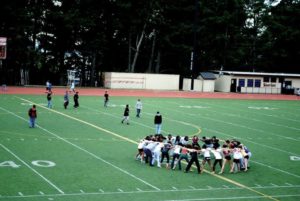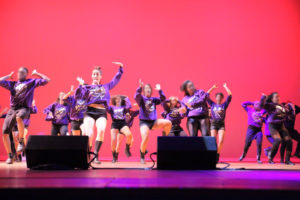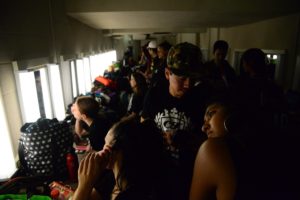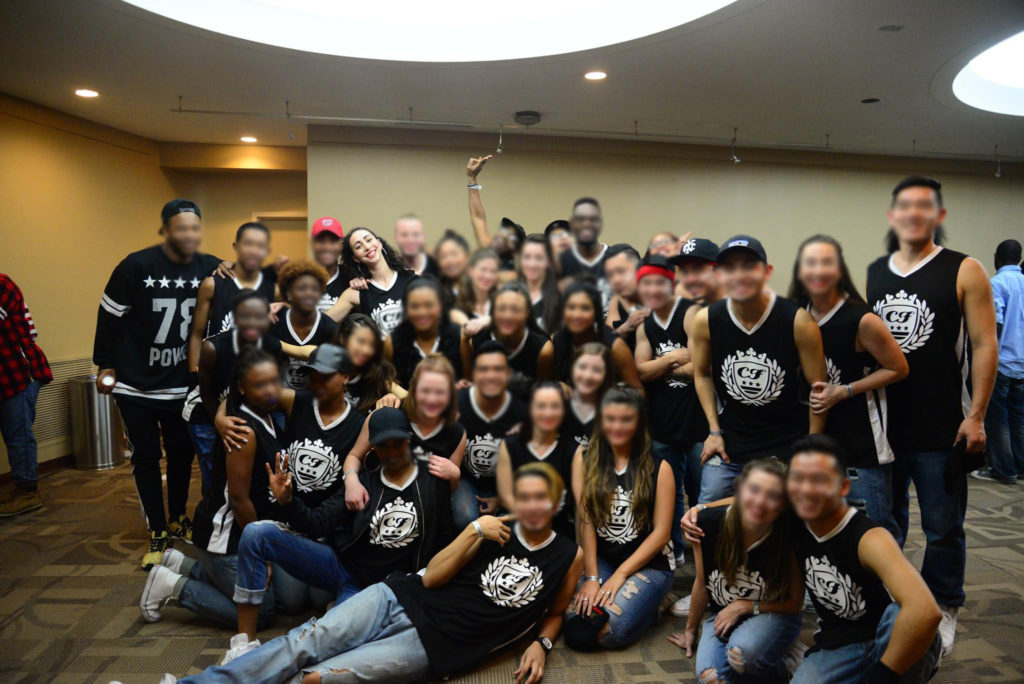
Photo courtesy of Hannah Ayasse. [ID: Four teenage girls sit on top of a wooden fence facing the sunset over Oakland, CA. The sky is full of vibrant yellow, pink, orange, purple and blue. The street and city lights are sparkling on the land, and the water of the San Francisco Bay reflects the pink of the sky.]
When I was a freshman in college, in the massive experience of culture shock,[1] I made a short dance video for a class final about home. I shot the video with my phone leaned against a makeshift tripod of books and chairs. The frame captures a dance studio with mirrors, wood floors, and a ballet barre and 18-year old me using the barre to dance from the left (west) to the right (east) side of the screen. It was a (not-so-discreet) metaphor for my journey from California to Washington DC and my confused feeling of displacement in trying to transition my sense of home from my upbringing placed entirely in Oakland, CA to a DC dorm room with a nice midwestern roommate who wanted me to coordinate with her nautical design preferences. To spoil the ending of this distraught dance from left to right of the studio, I ended up freeing myself from the ballet barre (which represented being stuck on the idea of home as material/tangible/physical place), moving to the center of the room, and finding the knowledge that through dance and embodiment practices I have come to understand that home is…get ready…“My Body.”
While that dance piece erred on overly simplistic, it reflected a central truth that I was touching then and has come into greater clarity in adulthood: home is a feeling more than it is a place. Home is what community feels like. Home is what familiar tastes, sights, smells, and sounds feel like. Home, like all sensations, really does exist in the body.
If we understand home as a place, I am still technically “home.” I am in the same place I lived when I was born. I still live in the East Bay. I am renting my aunt’s house in Berkeley but this isn’t the home I grew up visiting her in. It doesn’t register as the home I feel nostalgic for. It doesn’t register in my body.
When I moved back to the Bay after college, I went through the time warp of gentrification. I wanted to find an adult life, a life tapped into the art scene, a queer life somehow or another. There, I found myself surrounded by no one who felt like “Home Oakland.” I’m still looking. I’m still playing early 2000s hits when I’m homesick [2].

For my 27th birthday party, I had a kickball game. We drank capri-suns. We ate cheez-its and orange slices and someone brought McDonalds. We wore pennies over our shirts that we picked from a bag at random to unlearn all the small and large shames grown out of picking teams. We had a referee with red and yellow cards but she never pulled one because no one really knew if there were rules or what they were or if we were following them. We went back to my house for Zachary’s Deep Dish pizza and I played the playlist I had prepared titled “PUBERTY!!!” that started with “Me & U” by Cassie (my 7th grade ringtone [3]) and was full of the East Bay rappers from when everyone still thought of Oakland as “the hood” – Too $hort, The Pack, E-40.
I guess what I’m trying to say is that the Bay Area– and even more specifically, Oakland– has transformed so drastically since my childhood that when I think about home, I think about adolescence. A time when this place really FELT like home. The sense of belonging I felt. I think about the Bay Area I knew when my friends and I spent every free hour together [4]. We didn’t talk about belonging then as much as we do now on our group chat. We didn’t yet realize there was anything to say about our life experience. We didn’t yet need to define the comfort we felt in community. It felt inevitable then.

We relied on each other and we knew it. We weren’t fooling ourselves into the myth of self sufficiency, we were aware that we were all being raised by the entire community. We were less aware that we were indelibly forming each other’s personalities, value-systems, and sense of identity [5]. We were transforming and had no doubt that we were doing it together.
Adolescence is cyclically relevant right now. If being a teen is the time when we are supposed to break our previous ways of seeing our reality in order to make room for a newly centered adulthood, we are in a collective adolescence at the moment. An inherent part of puberty is that discomfort is necessary for growth. That’s a lesson from adolescence I am holding on to in order to survive transformation [6]. Discomfort is necessary for growth but it passes, it always passes. Like adolescence, this is a massive moment of awkwardly moving through and towards [7], the exhilaration [8] and the doom [9] and the overcompensation [10], the behaving as if we’ve already made it to the other side as a way of coping with the chaos of transformation [11].
Honestly, I am not sure how long adolescence on a collective scale [12] really lasts but I am trying to lean into it while it’s here. I am trying to remember a changing body and I am trying to remember belonging. I am reminding myself that I know how to change and I know how to belong because I was taught how to change and how to belong.
I think maybe this is part of why I am still dancing. Dance taught me these lessons through physical practice and social reliability. I could talk forever about improvisation and the ephemeral nature of performance and outline all the ways that dance teaches the body to shift. A choreographer I once trained with used to say “Once it’s polished, it’s died.” [13] He knew that the goal was not to reach anything certain. He knew that the practice and performance of live, body-based art relied on the aliveness of change. He used improvisational scores and small shifts and changes in the plan as a way to keep the performers alert, awake, and engaged on stage. Dancers understand the near impossibility of doing any one thing in exactly the same way every time because sometimes we try. We understand that striving for and achieving perfection do not have to go hand in hand. We practice listening to what arises and following impulses and presence presence presence.
That’s the physical stuff. Then, there is the social. Then, there is the reliable formula of finding the dance class, finding the dance team, finding the dance floor when I wanted to find community.

Dance community was the kids everyone wanted to be in high school. Dance community was the pre-show announcement not to scream the dancers’ names during the performance because it was distracting and then everyone doing it anyway [14].
Dance community was the familiarity of home through the Hip Hop team in college. A respite from the courses that counted as college credit and brought a realization that dance could also be cerebral. A reminder that my first entry point to dance was music, was a drum, a mirror for the heartbeat.
Dance community was discovering and living into my queerness as a young adult. Looking around and seeing that the people who could imagine taking on the choreography of their own time, their own life, were the peers that kept dancing or started dancing after unmooring from the institution of school. Then even within the widening world of dance and art-making on our own terms, the people who reflected my own experience were all queer.

Dance community as a foil for whatever it needs to be at the time. Dance community as a place where we meet with our bodies, speaking in expansion and contraction, in energy and force, softness and articulation. Screaming on the sidelines during practice to give the team energy or pressing your thumb into a stranger’s psoas because we are learning to release tension together. Laying our bodies down together or letting our bodies be alone. Learning to ask “what does my body need in this moment” over and over and over again and knowing that the answer will be different over and over and over again.
Something about how people who find themselves in dance space meet each other relationally, physically, empathetically.
I guess what I’m trying to say is that if home is just that, a sense of belonging, then dance helped me learn to belong in my own body. What I am trying to say is: thank you to the teachers who brought me that gift, offered that to me as I was growing into myself, the ones who affirmed my voice and my grounding in my body. Thank you Pope Flyne. Thank you Day 1’s [15]. Thank you Zafra Miriam. Thank you Dawn James. Thank you Capital Funk. Thank you Oakland even though you’ve changed. Thank you body even though I’ve changed.

[1] Shock like jumping into a freezing cold lake and the air getting sucked from your lungs. Shock like your brain is not going to come back online for a second because it’s too busy trying to figure out where it is and what the new rules of this new game are. Shock as in everything you learned about how to relate to people as a child has now stopped working and people laugh at you rather than with you now so maybe that’s who you are and are you actually okay with this new reality, you worked so hard to get here but you never actually imagined what here would feel like and you did not know it would be so different why didn’t anyone tell you.
[2] I’m playing T-Pain and Natasha Bedingfield and Cassie and Maroon 5 and Lloyd and The Fray and Chingy and Ciara and some of them are still making music but nothing as good as “Goodies” or “You” or “Songs About Jane.”
[3] “Yooouu’ve been waiting so long, I’m here to Answer. Your. Call.”
[4] When we mostly saw the inside of each other’s parents’ homes but also hours and hours of walking neighborhood streets and trying to take public transportation all the way to Stinson beach for Y’s 15th birthday and hanging out in parking lots. So many hours in parking lots. I think about J’s blue minivan speeding through the dark streets of the Oakland Hills blasting Frank Ocean and Erykah Badu and Sade.
[5] It was something about how we were all so radically different. Have you ever played that card-matching game called “Set”? The gist is that you look at a grid of nine cards on the table, all with different colors, shapes, and shadings and you need to find sets of three. Without getting too deep into it, on one end of the Set spectrum is 3 cards that are very alike (all red for example) and the other end of the spectrum is three cards that share absolutely no quality. We were a set like that, a group that clicked perfectly together because we were all fully different.
[6] Actually can I say thrive? Let’s say thrive through transformation.
[7] Awkward is okay and there is a future we are moving towards even if we cannot see it clearly.
[8] The energy of this time is charged, we will not always be overwhelmed, we may later look back and long for this electricity.
[9] “No matter how bad things get, they are always changing” – T.L. Simmons, Long Lost Oakland.
[10] Performance is a big part of figuring all of this out, if you are faking it someone else is too. What are you performing and why?
[11] We used to think the cashiers at the liquor stores in the Dimond probably really thought that L was 22 and that we all definitely needed to go to the East Coast for college because we were big city people destined for all the glamor and adulthood that the other coast had in store for us. The ideas we have for a more just future are here with us now but they don’t yet exist, some of them will come, some of them will transform, we will transform alongside.
[12] You’re thinking what I’m thinking, right? This pandemic, this social and political upheaval, this climate crisis, this war, this Octavia-E.-Butler-truly-was-a-seer apocalyptic reality has to be transformation, right? There is something on the other side. This is what being on the way feels like, right?
[13] Hannes Langolf
[14] Ms. James getting on the mic from the tech booth between dances saying “I repeat, kindly do not holler at the dancers during the performance or we will need to bring the lights up.” But she knew, we all knew, when you are moved you’ve got to holler. When you’re 16 sitting down in a dark room watching your best friend jump and fly, your voice is all you have to bring your body closer. My friends in the audience were still children enough to participate and almost adult enough to be afraid to be seen in the light.
[15] Y, J, L, J, M
This article appeared in the Spring 2022 issue of In Dance.


